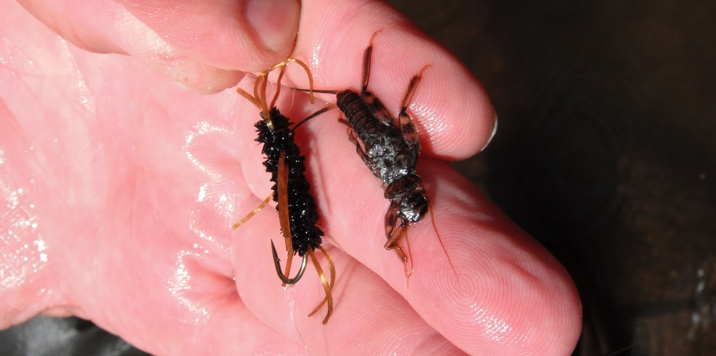It's time to close this initial thread and move on to other things. So here is the last installment of flies that proved themselves in 2013. Will they be the same in 2014? Only time will tell. This final installment includes two dries, two nymphs, and a streamer. A friend recently mentioned to me that my selection doesn't include that many dries. This is completely true. Although I prefer catching fish on top, I catch more fish subsurface and this selection of 20 flies features those that put the most fish into my net this past year.
16. Elk Hair Caddis
This is a classic fly pattern that should be in every fly selection. It is durable, floats well, and catches fish. The fly works best during a caddis hatch when the adults are skittering across the surface. Various caddis flies emerge all summer long, and unlike mayflies, the adults can survive in stream-side vegetation for several weeks. So this fly works well as a searching pattern even if there aren't any caddis hatching. At times, you'll probably also need a lower profile pattern to imitate spent or egg laying caddis, but this fly is a good place to start when you observe caddis activity. Tightline Productions has produced a great tying video.
17. LaFontaine's Foam Beetle
This pattern was a new entry to my fly box this past summer and it quickly earned a returning spot in the lineup. I learned about this pattern from Gary LaFontaine's book Trout Flies: Proven Patterns. I intend to provide a more thorough overview of the book in the future, but for now, take my advice and buy yourself a copy if you're into tying flies. This fly is not your typical foam beetle. Think of it more as a trimmed Griffith's Gnat with a closed-cell, packing foam wing. It doesn't look like much but it works. On a trip to the Spotted Bear River, this fly took every rising fish from a pool, even those that had rejected several gaudier terrestrials.
18. Barr's Slumpbuster Streamer
It's easy to get carried away with streamer patterns. They're a lot of fun to tie and fish. Nowadays, it seems like massive articulated patterns are the norm. There's a time and a place for them, but I typically find myself fishing something a little smaller and more simple like Barr's Slumpbuster Streamer. I like them in natural color schemes, but black seems to work well in off colored water and white seems to work well at times that remain mysterious to me. In addition to the hook and conehead, the fly only uses two other materials: zonker strips and body braid. Check out this link for an Orvis blog article by Eric Rickstad featuring a tying video by Kevin McKay.
19. Damselfly nymph
I love flies that incorporate hare's ear and I love weird hooks. When I first saw swimming larvae hooks in the fly shop I had to buy a pack. These hooks give the fly a cool swimming profile. The above picture is from an article at flytyer.com by John Gierach (as close as you can get to a hero of mine). I tie my pattern the way he describes it in his book Good Flies. I think of this pattern primarily as a lake fly, but it also works well in sections of slow moving water in rivers. It also makes a passable hexagenia nymph (pictured below) which would be found in similar habitats as damselfly nymphs including a good hatch on Whitefish Lake in late June / early July.
20. Girdle Bug
This pattern is so ugly it's charming in it's own way. It's usual purpose is to sink another fly, but it catches its fair share of fish. It's a great year-round fly here in the Flathead River system where large stoneflies are found in the river all year round. It's also a pretty easy tie. Check out this tying video by Rob Weiker of Lakestream Fly Shop. The pattern doesn't look very realistic when dry, but once it gets wet it is a dead ringer for golden stone or salmonfly nymphs depending on its size and color scheme. This picture from fishinmissions blog shows what a realistic imitation it can be. I like to fish the pattern in brown or a variegated brown and black color scheme.
Photo Credits:
Elk Hair Caddis pic taken from tightline productions vimeo page.
Lafontaine's Foam Beetle pic taken from www.flyanglersonline.com
Barr's Slumpbuster Streamer pic taken from www.hatchesmagazine.com
Girdle Bug Pic taken from www.lakestream.com
Damselfly nymph pic taken from www.flytyer.com






No comments:
Post a Comment